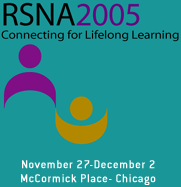
Abstract Archives of the RSNA, 2005
Giovanni Guido Pompili MD, Presenter: Nothing to Disclose
Salvatore Zirpoli MD, Abstract Co-Author: Nothing to Disclose
Giuseppe Franceschelli MD, Abstract Co-Author: Nothing to Disclose
Alberto Magenta Biasina MD, Abstract Co-Author: Nothing to Disclose
Francesco Sardanelli MD, Abstract Co-Author: Nothing to Disclose
Gian Paolo Cornalba MD, Abstract Co-Author: Nothing to Disclose
To evaluate frequency and type of renal lesions in patients with clinically or genotipically proven tuberous sclerosis complex (TSC).
We studied a total of 24 patients, 16 females (mean age 31.7±15.2; range 11-62) and 8 males (mean age 25.3±13,4; range 5-47) afflicted with clinically or genotipically demonstrated TSC. Abdominal MR imaging was performed at 1.0 T (Philips, Intera NT) using 5-7 mm thickness unenhanced axial T1-w. gradient-echo (GE), coronal T2-w. fast-spin-echo, and coronal fat-sat T1-w. GE, and spectral presaturation with inversion recovery T2-w. fast-SE as well as Gd-enhanced (0.1 mmol/kg) axial T1-w. coronal fat-sat T1-w. GE sequences. We considered the presence of either cysts or angiomyolipomas (AMLs) classed as follows for each kidney: I (1-10 lesions); II (11-30); and III (over 30). We also considered the size of the major cyst and AML per patient. We finally staged the overall involvement by cysts and AMLs for each kidney: less than one third; between one and two thirds; and more than two thirds.
Out of the total of 24 patients, seven(29%) had only AMLs; eight(33%) had both AMLs and cysts; five(21%) had only cysts; and four(17%) had no evidence of renal lesions. One patient was monorenal; in two patients AMLs were unilateral; in two other patients cysts were unilateral. AMLs were identified in 15/24(63%) patients (eleven females and four males) and in 27/47(57%) kidneys. Of the 27 kidneys in which AMLs were found, eight were class I, ten class II and nine class III. The mean diameter of the largest AMLs was 43.4 mm (range 3-100). Cysts were identified in 13/24(54%) patients (nine females and four males) and in 24/47(51%) kidneys. Of the 24 kidneys in which cysts were found, twelve were class I, nine class II and three class III. The mean diameter of the largest cysts was 26.5 mm (range 2-130). The stage of overall renal involvement was less one third in 18/47(38%), between one and two thirds in 11/47(24%) and more than two thirds in 9/47(19%). There was no evidence of lesions in the remaining nine kidneys.
A high frequency of renal involvement occurs in patients with TSC, 20/24 patients (83%) being affected with AMLS and/or cysts.
Pompili, G,
Zirpoli, S,
Franceschelli, G,
Magenta Biasina, A,
Sardanelli, F,
Cornalba, G,
Renal Involvement in Patients with Tuberous Sclerosis Complex. Radiological Society of North America 2005 Scientific Assembly and Annual Meeting, November 27 - December 2, 2005 ,Chicago IL.
http://archive.rsna.org/2005/4408211.html

